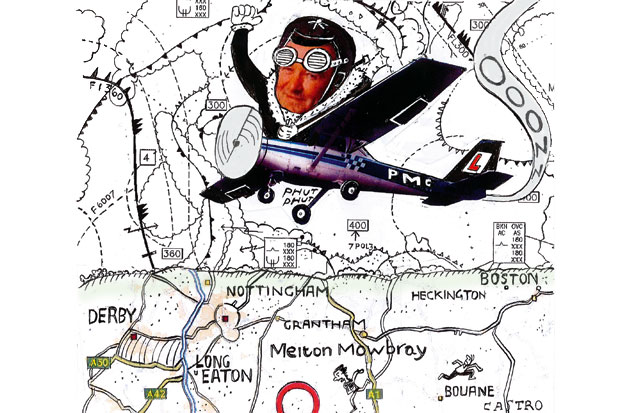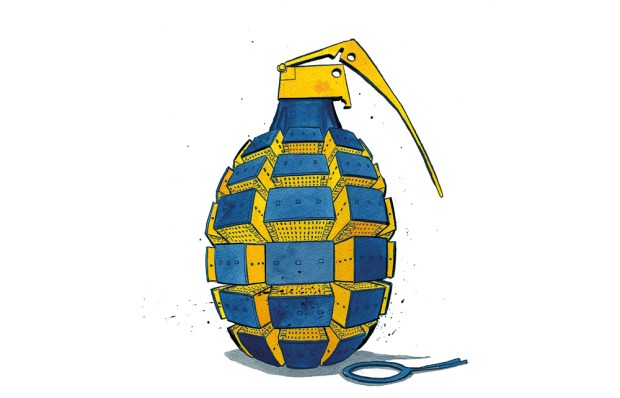We’d taken off smoothly and the two-seater Cessna 152 was climbing through 1,000 feet on full power. Then my instructor, Gill, reached over and closed the throttle. As the plane’s nose began to sink, she told me calmly, ‘We’ll simulate an emergency now. Can you find a suitable field to land in?’ Hurrying panic wouldn’t look good, I felt. On the other hand, finding somewhere more or less immediately might be appreciated. An empty-looking golf course fairway below looked promising. It had two sand bunkers, probably easier to avoid with a plane than a golf club, but what if previously unseen golfers pulling buggies strolled out of the trees into my flight path on touchdown? A lush-looking green field to the right looked big, firm and long enough. No people or animals. Not ploughed. Ploughed is a real no-no when it comes to landing aeroplanes.
‘OK, I think we’d walk away from landing there,’ said Gill, pushing the throttle back to full power. I’d passed another of the almost-constant little tests that shape pilot tuition. There are no good landings, I am told. They’re ‘landings you walk away from’. Learning to fly is necessarily concerned with how to avoid not flying, or crashing as it’s known in lay terms. The late David Frost, asked if he wasn’t afraid of the flying — he was travelling to New York twice a week to present a TV show at the time — replied: ‘Crashing, yes. Flying, no.’
The term ‘crashing’ is avoided by real pilots. ‘Bought the farm’ is popular. It’s thought to be from the 1950s when the families of US military pilots who had died in crashes received insurance payouts large enough to pay off farm mortgages. ‘Bought the plot’ was earlier RAF slang, which of course refers to funeral arrangements.
I belong to the Enstone Flying Club, near Chipping Norton, Oxfordshire, based at RAF Enstone, the former wartime bomber base. The airfield has an 1,100m asphalt runway and two 800m grass ones. Run for nearly ten years by the 53-year-old ‘skipper’ Paul Fowler, it has eight instructors and a reputation for being friendly and unstuffy.
Sam Quinn, who you may have seen in Channel 4’s recent documentary series Worst Place to Be a Pilot, trained with the Enstone Flying Club. Worst Place to Be a Pilot follows the adventures of young British men accumulating flying hours and experience in short-hop aviation in the hopes of eventually becoming captains on jumbo jets.
In one episode, Quinn flies an eight-seat, one-engine, turbo-prop, 200-miles-an-hour Cessna Caravan (known fondly by some as the Flying Shed) to deliver supplies to quarrelsome Papuan mountain folk. He is supposed to land on a short, very challenging airstrip carved out of the rocks. ‘When bows and arrows are drawn, he makes a swift exit,’ we are told.
No such hazard when I (accompanied by Gill) navigate to Melton Mowbray, Leicestershire, although we chose not to land among its legendary pie-making people; cruised around Moreton-in-Marsh, Gloucestershire, where they were erecting marquees for the annual show; circled — at a distance, to cut noise pollution — the dreaming spires of Oxford, as well as sundry points north, south, east and west.
I have passed my air law, operational procedures and communications exams, with only six more to go. Now I’m deep into navigation. On the special map of UK air space, we draw triangular journeys. Then, after measuring the prevailing wind’s velocity and direction, compute a route that will compensate for its effect, taking us directly on each leg of our destination. As part of the training, I have completed several powerless landings, as well as flapless ones, gliding the Cessna back to the airfield, keeping the speed high enough to avoid stalling but not so high as to make landing hazardous. Ideally, you arrive at the runway threshold in a controlled, composed condition, making a safe landing feasible.
And, of course, there have been many touch-and-go sessions — landing briefly, immediately taking off again, circling the airfield in the 800ft circuit, sometimes in the company of other trainee fliers — always a tense, watchful experience. (Bob Hope told a story about landing in Alabama in his private jet; his pilot complained to the tower that another plane was approaching the same runway from the opposite direction and was told: ‘Now y’all be careful, y’hear!’) At the end of one session, after I’d landed more or less tidily — cross winds in the last 50 feet can turn a smooth approach into a ride on a rollercoaster — Gill asked me to taxi off the runway and onto the grass where there’s a small control tower.
‘Right, off you go, I’ll talk to you on the radio.’ She smiled, climbing out of G-BODO — the euphonious Gulf, Bravo, Oscar, Delta, Oscar. My solo! Taking off, climbing into the circuit. Cruising downwind, advising other Enstone traffic of same. Remembering my ‘Bumffichh’ pre-landing checks — Brakes off, Undercarriage fixed down; Mixture, rich; Fuel, on; Flaps, as required; Instruments, all OK, Carb heat, set; Hatches, secure; Harnesses, fastened. Then turning in for ‘finals’, advising other Enstone traffic of same, selecting a suitable landing speed (65 knots, about 75mph) and degree of flap (20).
It went very well, since you ask. The solo is important for the trainee, but all it proves is that your instructor thinks you’ll remember the basic rules during a brief flight and won’t seize up with fright. I’d seen another trainee doing well until he touched down. Then his plane ran off the runway onto the grass, which was soft after rain, and bogged down. Before starting the course, I’d thought ‘going solo’ meant you could then call yourself a pilot, but first there’s a universe of facts and figures, laws and customs, to learn about flying. Including where you can and can’t do it. The paperback tuition volumes in my flight briefcase weigh nearly nine kilos.
Learning to fly is hard, mentally and physically, but it’s uplifting in more senses than one, and it’s like nothing else I’ve done. I used to think that nothing could compare with riding a powerful, good-handling motorbike on ‘full chat’, but it’s merely an earthbound version of the real thing. The best descriptions I’ve read are in First Light, a memoir by Geoffrey Wellum, who was taught to fly a Spitfire aged 18 and fought in the Battle of Britain. During his training, after getting the feel of the beast:
Elation! We sweep effortlessly about the sky, upwards between two towering masses of cumulus cloud and through a hole like the mouth of a cave beyond which lies a valley leading into clear sky… I revel in the sheer beauty of the scene around me.
As a boy, one of my heroes was a pilot. I read The Rover, which serialised ‘I Flew With Braddock’, a story about a fictional aviator who was introduced thus by his fictional biographer: ‘Sergeant-pilot Matt Braddock, VC and bar, was one of the greatest airmen of the second world war. He antagonised every person he met, but even those who regarded him with bitter resentment and hostility admitted that in the air Braddock had no equal.’
Among many feats of derring-do, Braddock sank a U-boat, bombed German rocket labs, downed an enemy fighter with a flare gun and sank one of their aircraft carriers. When we weren’t antagonising every person we met, my chums and I spent happy summer days ‘controlling’ action at the deserted RAF Dallachy, near Elgin, Moray, which had closed in 1945. Today the runways and aprons are shrouded by vegetation but the ruined tower lures me still.
Got something to add? Join the discussion and comment below.
Get 10 issues for just $10
Subscribe to The Spectator Australia today for the next 10 magazine issues, plus full online access, for just $10.
You might disagree with half of it, but you’ll enjoy reading all of it. Try your first month for free, then just $2 a week for the remainder of your first year.














Comments
Don't miss out
Join the conversation with other Spectator Australia readers. Subscribe to leave a comment.
SUBSCRIBEAlready a subscriber? Log in